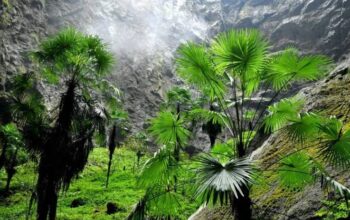The Great Salt Lake is drying up to its lowest level on record for the second year in a row
Utah’s GreatSalt Lake is the largest saltwater lake in the Western Hemisphere
The following written content from Rosie Nguyen
The silvery blue waters of the Great Salt Lake sprawl across the Utah desert, having covered an area nearly the size of Delaware for much of history.
For years, though, the largest natural lake west of the Mississippi River has been shrinking and a drought gripping the American West could make this year the worst yet. The lake’s levels are expected to hit a 170-year low this year.
The receding water is already affecting the nesting spot of pelicans that are among the millions of birds dependent on the lake. Sailboats have been hoisted out of the water to keep them from getting stuck in the mud. More dry lakebed getting exposed could send arsenic-laced dust into the air that millions breathe. It blows through a region that already has some of the dirtiest wintertime air in the country because of seasonal geographic conditions that trap pollution between the mountains.
This year is primed to be especially bleak. Utah is one of the driest states in the country, and most of its water comes from snowfall. The snowpack was below normal last winter and the soil was dry, meaning much of the melted snow that flowed down the mountains soaked into the ground. Most years, the Great Salt Lake gains up to 2 feet (half a meter) from spring runoff. This year, it was just 6 inches (15 centimeters), according to experts. Pelican breeding ground threatened at Great Salt Lake
The swirling dust also could speed the melting of Utah’s snow, according to research by McKenzie Skiles, a snow hydrologist at the University of Utah. Her study showed that dust from one storm made the snow so much darker that it melted a week earlier than expected. While much of that dust came from other sources, an expansion of dry lakebed raises concerns about changes to the state’s billon-dollar ski industry.
A study from Utah State University says that to maintain lake levels, diverting water from rivers that flow into it would have to decrease by 30%. But for the state with the nation’s fastest-growing population, addressing the problem will require a major shift in how water is allocated and perceptions of the lake, which has a strong odor in some places caused by treated wastewater and is home to billions of brine flies.

Lindsay Whitehurst, the reporter with the Associated Press who wrote the article about the Great Salt Lake on Tuesday joined ABC4’s Rosie Nguyen on the CW30 News at 7 p.m. for an IN FOCUS discussion about her findings. She shared what led her to reporting about the topic, what jumped out to her about the story, the affect on migratory birds, the impact on people who boat and recreate on the lake, and what worries her the most through what she learned about the lake.
Rep. Tim Hawkes of Centerville, who represents the brine shrimp industry and Dr. Kevin Perry, associate professor of atmospheric science at University of Utah discussed the economic and environmental impact of the lake’s current state. They talked about which industries rely on the Great Salt Lake, how the declining levels are affecting those industries, how a smaller lake will have an impact on our snowpack, what Utahns can do to help alleviate this issue, and how dire they think the problem is right now. Read more from Abc4





